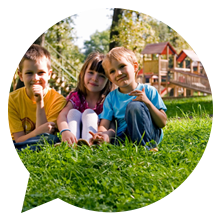Grass as a play area surface

Introduction
There has been some debate over the use of grass on children's playgrounds and its effectiveness in injury prevention if provided as an impact attenuating surface (IAS).
Injuries on playgrounds
Injuries to children on playgrounds are inevitable. One of the functions of children's play is about exploring the environment, the objects in it and the child's own body and mind. Play is about doing and it is inevitable that mistakes will happen. RoSPA's function is to reduce the severity of injuries - not to remove all possibility of harm. In achieving this we look at accident causation, review the available research and apply a risk assessment to the playground, its equipment and surfacing. We must also have a concern for what is technically and financially possible.
Falls from equipment
Falls from one level to another are the most common cause of playground injury. In any injury there are two factors:
- could the fall have been prevented
- could the resulting injury have been prevented or reduced in its severity
Fall prevention is a matter for the equipment designers and the playground designers. Injury prevention is seen as one of the functions of the surface material.
Impact absorbing surfaces
The use of impact absorbing surfaces is an area in which there has been, and still is, a great deal of ill-informed comment. Injuries to children are an emotive subject and too often result in a knee-jerk reaction. For an authoritative review of the subject, the research paper prepared for the UK Health and Safety Executive by Professor David Ball (www.hse.gov.uk/research) is worth reading. This reviews accident data and research studies in many different countries. The conclusions are reflected in the current advice of the Health and Safety Executive that appropriate surfaces are one of the factors contributing to playground safety.
There is no legal requirement to provide IAS but consideration of its use is seen as evidence of good management practice.
It should be noted that the effectiveness of IAS in injury prevention is limited and there is little scientific evidence to support the claims made for it, especially in long-bone fractures resulting from body weight descending on the limb or an awkward fall. It may reduce the severity of certain types of fall, for example, onto a joint. It may reduce the severity of the relatively rare head injuries.
Use of grass
Grass is a popular material on children's playgrounds although principally used for the spaces between equipment. It is a natural material and therefore has some strong developmental value for children, especially if mixed with wild flower seeds and subjected to a less enthusiastic mowing regime. Longer grass will help the soil to retain moisture for longer.
EN 1176 and 1177
These are the two standards which cover playground equipment and surfacing in the UK and, while not mandatory, represent good practice and would be referred to in any court action.
EN 1176:2008 has a British derogation that recommends that well maintained grass with at least 150mm of sub soil is a suitable surface for falls up to a height of 1500mm (subject to a risk assessment). It has therefore become common for lower items of equipment to be sited on grass. Our impact attenuation tests have shown that in a temperate climate such as that in the UK, grass grows well and provides a satisfactory level of impact attenuation for most of the year. In dry weather it does tend to break up and performs like a loose IAS (such as bark or wood chip) surface.
There will, however, be times during dry spells or freezing weather when it is harder although one study noted little difference between grass, rubber and timber products in freezing conditions.
Falls to grass surfaces
There are a small number of the studies which compare grass surfaces against other types of material. In general they find few advantages in using a synthetic or LIAS material over grass for low-level falls – the injury rate was similar for grass, LIAS and rubber. Although there are limitations in all the statistical studies there does seem to be some evidence of the effectiveness of grass as an IAS.
The main objection to using grass as an impact material relates to wear and where this is likely a firm surface or grass reinforcement material might be helpful in reducing rutting.
RoSPA's view
In our opinion grass is a suitable material for use under and around equipment from which falls of less than 1500mm are possible, although where continued scuffing takes place firm surfaces should be considered.